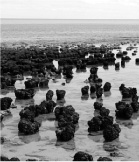
|
What are stromatolites?
Biology and Life
Read more from
|
Stromatolites are large rock masses that grow outward and upward thanks to layer upon layer of light using photosynthetic cyanobacteria and other aerobic (oxygen-consuming) microbes. Found on every continent—especially in such places as Western Australia, Florida, and other warm climates—they resemble giant, layered mushrooms that grow in shallow seawater. Scientists study these structures to understand early life on Earth, as stromatolites existed over two billion years ago. They may not be the earliest forms of life, but they represent some of the first simple unicellular microorganisms on our planet and are thought to have contributed a hefty amount of oxygen to Earth’s ancient atmosphere.

